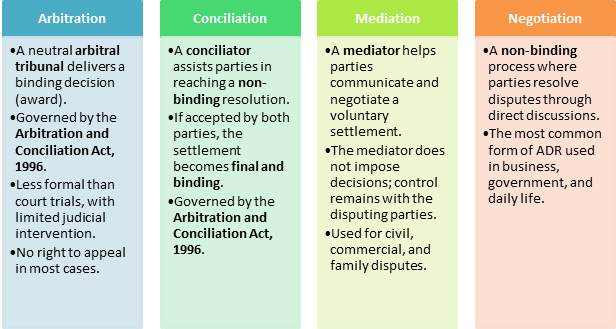Definition:
Alternative Dispute Resolution (ADR) implies mechanisms to resolve disputes outside traditional courts.
Types of ADR in India

Advantages:
-
- Confidentiality – Private proceedings protect sensitive information.
- Cost-effective & time-saving – Faster and less expensive than litigation.
- Flexibility – Custom solutions based on mutual interests.
- Less stressful – Avoids adversarial nature of court trials.
- Expertise – Arbitrators and mediators with domain-specific knowledge ensure fair resolutions.
Challenges:
-
- Limited appeal mechanisms – Arbitration awards have restricted review options.
- Non-binding nature – Mediation and conciliation rely on voluntary compliance.
- Power imbalance – Stronger parties may dominate negotiations.
- No legal precedents – ADR outcomes do not contribute to case law.
|
Recent Developments in ADR in India
|
Way forward: NITI Aayog recommendations
-
- Judicial Performance Index to track efficiency in dispute resolution.
- Administrative cadre for Judiciary to streamline case management.
- ICT integration for digital case management and electronic court systems.
- Decongesting courts through separate tribunals for commercial and traffic disputes.
International conventions related to ADR
a) New York Convention (1958) – Recognition & Enforcement of Arbitral Awards
-
- Also known as United Nations Convention on the Recognition and Enforcement of Foreign Arbitral Awards.
- Adopted by 172 countries, making it the most significant treaty for international arbitration.
- Ensures that arbitral awards given in one signatory country are recognized and enforced in another.
- Provides limited grounds for refusing enforcement, such as procedural irregularities, public policy violations, or lack of due process.
b) UNCITRAL Model Law on International Commercial Arbitration (2006)
-
- A blueprint for countries to draft arbitration laws in a uniform and harmonized manner.
- Recognized in over 85 jurisdictions, including India.
- Key principles: party autonomy, minimal court intervention, and enforceability of arbitral awards.
c) Singapore Convention on Mediation (2019)
-
- Also called the United Nations Convention on International Settlement Agreements resulting from Mediation.
- Signed by 55 countries, including India.
- Provides an international framework for enforcing mediated settlement agreements
- Aims to promote mediation as an effective alternative in cross-border commercial disputes.
d) ICSID Convention (1965) – Investment Disputes
-
- International Centre for Settlement of Investment Disputes (ICSID) is part of the World Bank Group.
- Provides an arbitration and conciliation framework for disputes between investors and states.
- Used in Bilateral Investment Treaties (BITs) to protect foreign investors from unfair treatment.
e) Hague Convention on Private International Law (HCCH) – Cross-Border ADR
-
- Provides mechanisms for cross-border enforcement of dispute resolutions.
- Ensures recognition of foreign court rulings and arbitral awards.
ADR Practices across the World
-
- Singapore
- A global hub for arbitration and mediation, with institutions like:
- Singapore International Arbitration Centre (SIAC)
- Singapore International Mediation Centre (SIMC)
- One of the first countries to ratify the Singapore Convention on Mediation.
- Offers hybrid ADR models, such as Arb-Med-Arb (Arbitration-Mediation-Arbitration) for faster resolutions.
- A global hub for arbitration and mediation, with institutions like:
- United States
- ADR is widely used in commercial and employment disputes.
- Federal Arbitration Act (FAA, 1925) governs arbitration.
- Mediation is mandatory in many civil and family law cases.
- Online Dispute Resolution (ODR) is growing in e-commerce disputes (e.g., eBay, PayPal).
- United Kingdom
- ADR is strongly promoted under the Civil Procedure Rules (CPR, 1998).
- Courts encourage parties to resolve disputes through mediation before litigation.
- London Court of International Arbitration (LCIA) is a leading global arbitration institution.
- European Union
- EU Mediation Directive (2008) requires all member states to encourage mediation.
- Arbitration laws follow the UNCITRAL Model Law.
- Court of Arbitration of the International Chamber of Commerce (ICC, Paris) is one of the most preferred arbitration bodies globally.
- China
- China International Economic and Trade Arbitration Commission (CIETAC) is a leading ADR institution.
- Mediation and arbitration are commonly used for foreign investment and trade disputes.
- Chinese courts promote online dispute resolution (ODR) for consumer disputes.
- Singapore
Lok Adalats
About:
-
- A form of Alternative Dispute Resolution (ADR) where civil and compoundable criminal cases—either pending or at the pre-litigation stage—are settled amicably.
- Established under the Legal Services Authorities Act, 1987.
- Awards given by Lok Adalats are final and non-appealable.
- Possess the same authority as a civil court under the Code of Civil Procedure (CPC), 1908.
- The first Lok Adalat was held in Junagarh, Gujarat, in 1982.
Over 7.7 crore cases were resolved through three National Lok Adalats (NLA) in 2024, as announced by the Chairman of NALSA
Key Features

Advantages
-
- Ensures speedy disposal of cases, reducing judicial backlog.
- Affordable and inclusive for marginalized communities.
- Encourages compromise, preventing hostility between disputing parties.
Limitations
-
- Limited authority as can only function with mutual consent
- No appellate mechanism
Way forward
-
- Public campaigns to educate citizens
- Capacity building to enhance efficiency.
- Technology integration to improve accessibility eg. virtual Lok Adalats
Family Courts
About:
-
- Established under the Family Courts Act, 1984.
- These aim to facilitate conciliation and speedy resolution of disputes related to marriage and family matters.
- Set up by state governments in consultation with the High Court.
Key Features:
-
- Mandatory for states to establish a Family Court in every city/town with over one million population.
- Handles cases related to matrimonial disputes, property of spouses, legitimacy declarations, guardianship, custody of minors, and maintenance of dependents.
- Courts must first attempt reconciliation through informal proceedings.
- No automatic right to lawyers; however, the court may appoint an Amicus Curiae for legal assistance.
- Procedural and evidentiary rules are relaxed for efficiency.
- Only one appeal to the High Court is allowed.
Commercial Courts
About:
-
- These are specialized courts to handle commercial disputes efficiently, ensuring quick resolutions.
- Established under the Commercial Courts Act, 2015.
- State Governments set up Commercial Courts at the district level for cases above a specified monetary threshold.
Key Features:
-
- Commercial Appellate Courts handle appeals against lower commercial courts.
- High Courts with original jurisdiction have Commercial Divisions for high-value disputes.
- Specified Value Threshold initially set at ₹1 crore, reduced to ₹3 lakh to expand accessibility.
- Before filing a suit, parties must undergo Pre-Institution Mediation.
Fast Track Courts (FTCs)
About:
-
- These are special courts established to expedite trials and ensure the swift disposal of long-pending cases.
- It has broad jurisdiction including (criminal cases, civil disputes, and matters related to human rights violations)
Key Objectives:
-
- Reduce case backlog
- Ensure speedy justice
- Improving efficiency of judiciary
- Strengthening the judicial system
Special Courts
About:
-
- These are courts with limited jurisdiction,
- They are established to handle cases related to specific areas of law.
- They handle cases related to bankruptcy, claims against the government, probate, family disputes, immigration, customs, and financial limitations.
Key Features:
-
- Established under the Special Courts Act, 1979.
- The establishment and operation of Special Courts fall under the jurisdiction of State government.
- Aim to enhance the legal framework and support marginalized sections of society.
- It consists of a sitting Judge of a High Court, nominated by the Chief Justice of High Court with concurrence of the Chief Justice of India (CJI).

